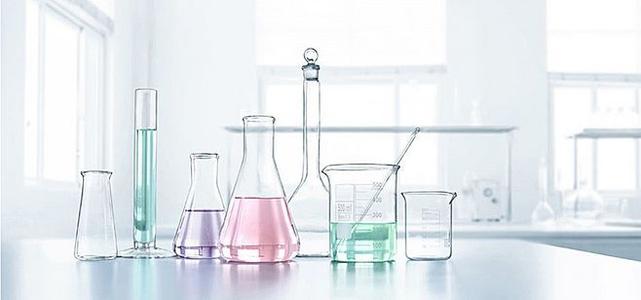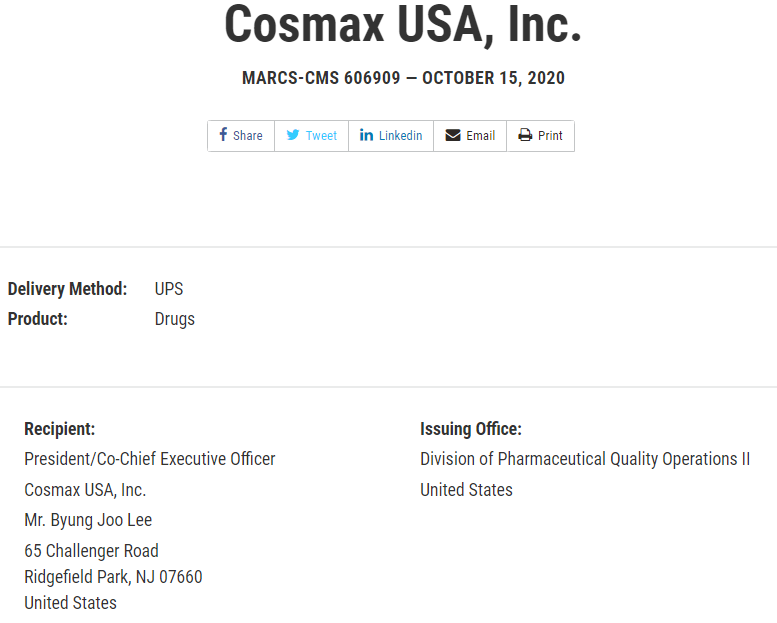扫一扫 添加小助手
服务热线
13818320332
扫一扫 关注我们
 11月3日,FDA公布一封针对美国本土企业(Cosmax USA, Inc)的警告信。主要的缺陷项涉及水系统偏差调查不充分、未进行中间体放置时间研究和清洁程序不一致。
11月3日,FDA公布一封针对美国本土企业(Cosmax USA, Inc)的警告信。主要的缺陷项涉及水系统偏差调查不充分、未进行中间体放置时间研究和清洁程序不一致。
检查发现,该公司在不到一个月的时间内,水系统某些取样点发生了多次微生物污染,但公司未进行充分的调查。对此,公司试图说明,由于偏差前后收集的其它样品结果都在限度范围内,因此认为总体上药品是没有风险的。
对于这样的解释,FDA显然并不能接受,原因是水系统中已经出现微生物污染的不利趋势,而微生物污染分布不均且难以在检验过程中检测到,因此必须从根本上解决水系统问题,而不是单纯靠检验结果说明产品的质量是否合格。
让我们一起看看该公司水系统的具体问题:

October 15, 2020
WARNING LETTER
WL #606909
Dear Mr. Lee:
2020年10月15日
警告信WL#606909
亲爱的李先生:
The U.S. Food and Drug Administration (FDA) inspected your drug manufacturing facility, Cosmax USA, Inc., FEI 1527228, at 30701 Carter Street, Solon, Ohio, from February 24, to March 17, 2020.
2020年2月24日至2020年3月17日,美国食品药品监督管理局(FDA)检查了你们的药品生产工厂Cosmax USA,Inc.,FEI 1527228,位于美国俄亥俄州索伦市。
This warning letter summarizes significant violations of current good manufacturing practice (CGMP) regulations for finished pharmaceuticals. See Title 21 Code of Federal Regulations (CFR), parts 210 and 211 (21 CFR parts 210 and 211).
该警告信总结了严重违反制剂CGMP规定的情况。请参阅21CFR第210和211部分。
Because your methods, facilities, or controls for manufacturing, processing, packing, or holding do not conform to CGMP, your drug products are adulterated within the meaning of section 501(a)(2)(B) of the Federal Food, Drug, and Cosmetic Act (FD&C Act), 21 U.S.C. 351(a)(2)(B).
由于你们用于生产、加工、包装或储存的方法、设施或控制措施不符合CGMP,因此根据FD&C法案501(a)(2)(B)条及21 U.S.C.351(a)(2)(B) 条的规定,你们的药品被认为是掺假。
We acknowledge receipt of your April 6, 2020, and your subsequent responses dated May 6 and June 6, 2020.
对于在2020年4月6日以及随后于2020年5月6日和6月6日的答复,我们确认收到。
During our inspection, our investigators observed specific violations including, but not limited to, the following.
在我们的检查过程中,调查员发现了具体的违规行为,包括但不限于以下行为。
水系统偏差调查不充分
1. Your firm failed to thoroughly investigate any unexplained discrepancy or failure of a batch or any of its components to meet any of its specifications, whether or not the batch has already been distributed (21 CFR 211.192).
1.公司未能彻底调查批次或其中任何组分的任何无法解释的差异或故障,无法满足其质量标准,无论批次是否已经分发(21 CFR 211.192)。
You used (b)(4) to manufacture your over-the-counter topical sunscreen drug products. Your firm failed to adequately investigate microbial out-of-limit (OOL) results from your (b)(4) system. For example, water sampled from (b)(4) on September 30, 2019, yielded an OOL result. Pseudomonas aeruginosa was identified. Your investigation noted that Pseudomonas aeruginosa was also found in samples taken from a different (b)(4) on September 11 and 20, 2019. Despite finding objectionable microbiological contamination in your water system (b)(4) times in less than a month, your firm failed to conduct an adequate investigation.
你们使用XX来生产局部防晒非处方药物。你们的公司未能充分调查XX系统的微生物超限(OOL)结果。例如,2019年9月30日从XX取样的水产生了OOL结果。鉴别出铜绿假单胞菌。你们的调查结果表明,在从其它XX采集的样品中也发现了铜绿假单胞菌,时间为2019年9月11日至20日。尽管在不到一个月的时间内,在你们的水系统XX次发现了有害微生物污染,但你们的公司未能进行充分的调查。
Your firm subsequently found additional water samples to be OOL, including Too Numerous to Count, between September and November 2019. In multiple instances, your investigations did not document the identity of the microorganism(s). Your firm also lacked control of the upstream part of your water system.
你们的公司随后在2019年9月至11月之间发现了其它水样品为OOL,包括数量过多而无法计数。在许多情况下,你们的调查未记录微生物的鉴别。你们的公司还缺乏对水系统上游部分的控制。
Your firm failed to adequately investigate the recurring microbiological failures. You lacked sufficient investigations into poor water quality and its impact on drug product quality. The presence of objectionable levels and types of microorganisms in your (b)(4) may have adversely affected the quality of your distributed drug products.
你们的公司未能充分调查反复发生的微生物失败问题。你们缺乏对不良水质及其对药品质量影响的充分调查。在XX中,当存在有害水平和类型的微生物时,可能会对你们分发的药品的质量产生不利影响。
Your response indicates that other samples collected for (b)(4) from before and after the occurrence were within limits, and you believe there was no risk to the drug product. Your response is inadequate. You failed to address the root cause of the adverse pattern of excessive and objectionable contamination in your water system. You also did not address any distributed product batches that may be compromised by microbiological contamination.
你们的回答试图说明,对于OOL发生之前和之后针对XX收集的其它样品,结果都在限度范围内,因此你们认为药物没有风险。你们的回应不充分。对于水系统中过多和有害微生物的污染的不利趋势,你们未能阐明其根本原因。对于可能受到微生物污染影响的任何已分发产品批次,你们也没有说明。
In response to this letter, provide the following:
针对此信,请提供:
• A comprehensive, independent assessment of the adequacy of water system design, control, and maintenance. One of the key elements of this independent assessment should be a retrospective review of all past monitoring results and critique of past investigations (including adequacy of root cause determinations) into the microbial contamination problems.
对于水系统设计、控制和维护的适当性,进行全面、独立的评估。这项独立评估的关键要素之一,应该是对所有过去的监测结果进行回顾性审查,并对过去对微生物污染问题的调查(包括确定根本原因的调查)进行评判。
• A thorough remediation plan to install and operate a suitable water system.
对于安装和运行合适的水系统,提供彻底修复计划。
• A detailed risk assessment addressing the potential effects of the observed water system failures on the quality of all drug product lots currently in U.S. distribution or within expiry. Specify actions that you will take in response to the risk assessment, such as customer notifications and product recalls.
详细的风险评估,就水系统故障,阐明其对当前在美国分销或效期内的所有药品批次质量的潜在影响。说明你们将对风险评估采取的措施,例如客户通知和产品召回。
• An effective program for ongoing control, maintenance, and monitoring that helps ensure the remediated system consistently produces water that meets (b)(4), USP monograph specifications and appropriate microbial limits (i.e., total count, objectionable microbes).
一个有效的持续控制、维护和监视程序,可帮助确保修复后的系统始终产生满足USP专论质量标准和适当微生物限度(即总计数、有害微生物)的水。
• A water system monitoring procedure that specifies routine microbial testing of water to ensure its acceptability for use in each batch of drug products produced by your firm.
水系统监控程序,指定对水进行常规微生物测试,以确保其在你们公司生产的每批药品中的可接受性。
Describe in detail the frequency of sampling for each location that is monitored in your water system, and improved provisions for identification of microbes from water system point-of-use samples.
详细描述水系统中每个监测点的取样频率,并改进从水系统使用点样品中鉴别微生物的要求。
The current action/alert limits for total counts and objectionable organisms for your (b)(4) system.
对于对总计数和有害微生物,XX系统当前的行动限和警戒限。
A comprehensive, independent assessment of your overall system for investigating deviations, discrepancies, complaints, Out-of-Specification (OOS) results, and failures. Provide a detailed action plan to remediate this system. Your action plan should include, but not be limited to, significant improvements in investigation competencies, scope determination, root cause evaluation, Corrective Action and Preventive Action (CAPA) effectiveness, Quality Unit (QU) oversight, and written procedures. Address how your firm will ensure all phases of investigations are appropriately conducted.
对整个系统进行全面、独立的评估,以调查偏差、差异、投诉、不合格(OOS)结果和故障。提供详细的行动计划,以补救此系统。你们的行动计划应包括但不限于在:调查能力、范围确定、根本原因评估、纠正和预防措施(CAPA)有效性、质量单元(QU)监督,以及书面程序方面的重大改进。对于调查的所有阶段,说明你们的公司将如何确保其适当执行。
A retrospective, independent assessment of all OOL and OOS results for water, ingredients, containers and closures, in-process materials, and finished product since January 1, 2018, to present. Provide a summary of each incident that includes batch number, date, presumed root cause(s), CAPA, and an independent evaluation of CAPA effectiveness.
自2018年1月1日至今,对所有OOL和OOS的水、物料、容器和密封件,在制品以及成品的结果进行回顾性独立评估。提供每个事件的摘要,包括批号、日期、假定的根本原因、CAPA,以及对CAPA有效性的独立评估。
Ref: WARNING LETTER- Cosmax USA, Inc.,MARCS-CMS 606909. OCTOBER 15, 2020. FDA.
文章来源:PharmLink
本网站刊载的所有内容,包括文字、图片、音频、视频、软件等,如非标注为“原创”,则相关版权归原作者所有,如原作者不愿意在本网站刊登相关内容,请及时通知本站,我们将第一时间予以删除。